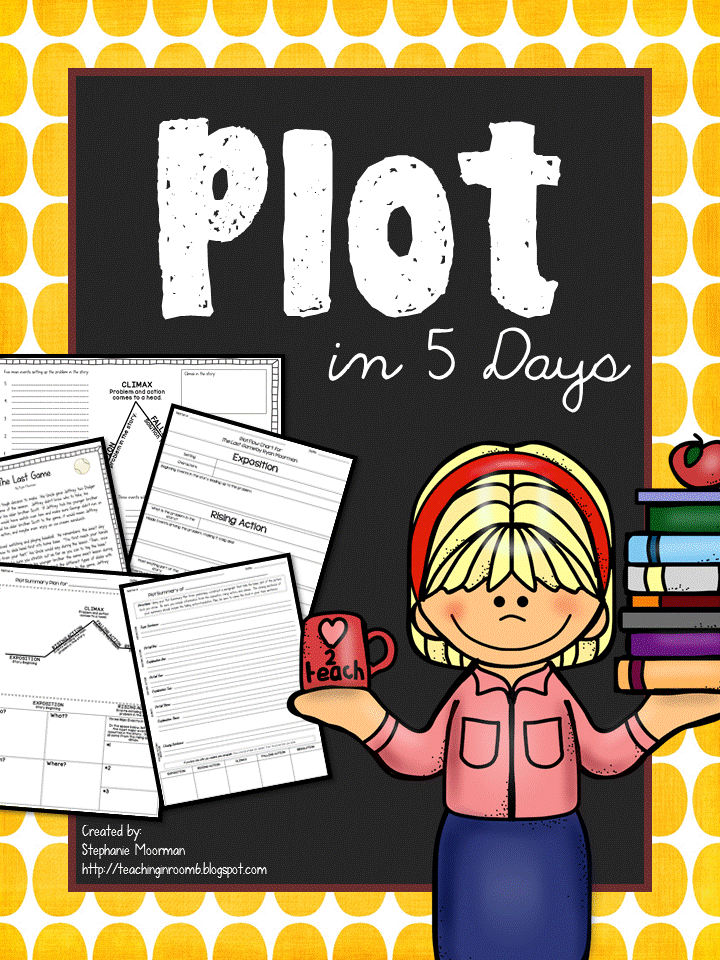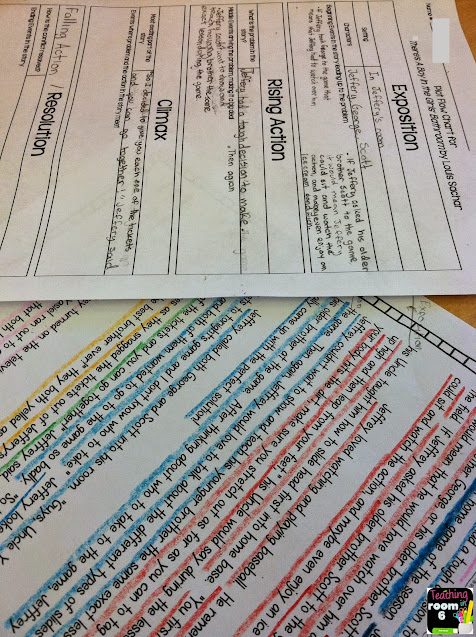With those great reads comes great lessons. Books (in general) have a beginning, middle, and end. They start with introductions, take the reader through many different actions which lead to the climax, that point we have been waiting for, and then solve the problems with a nice, neat ending. (OK, OK...I know not every.single.book does that, but I am talking in general!) So this past week, I wanted to focus on that story structure we call PLOT and bring it to the attention of my students.
One thing that I have been doing, and have written a bit about in the past few weeks, is take a large reading topic (character, setting, plot) and teach it to my students over the course of the week. I break the idea into smaller, 20 minute chunks, and teach from there. It is working so very well! This week's chunk lessons all dealt with the idea of plot and how everything we read follows the same basic "formula".
 We started with an anchor chart describing each part of the plot diagram.
We started with an anchor chart describing each part of the plot diagram.What is exposition?
Why is rising action the longest part?
What does climax do for the story?
Falling action and resolution are different?
Then, we discussed how There's A Boy in the Girls' Bathroom
Day Two and Three had us looking at a story (written by my husband!) and trying to dissect it for plot elements. We read the story aloud, and then color coded the story using our crayons to represent different elements of plot. Deciphering between the exposition and rising action, and then falling action and resolution proved to be quite challenging! Our discussion kept us moving along though and the students were able to do this quite well.
On these days, I wanted them to create a little drawing/writing project that would keep them interested in the story and also serve to get their ideas from the oral discussion to a more written, concrete form. So I asked the students to take the color-coded writing and draw a picture for each of the five elements. What picture would represent the exposition? What about the climax? How would the resolution be drawn?
That then lead us into the writing portion of this for the week. I wanted the students to be able to write a clear, coherent paragraph on the subject of plot so for Day Four and Five, I had them choose a picture book that they were familiar with. I guided them towards books that I knew had a clear beginning, middle, and end (ie: Madeline
Then, using a paragraph organizer, I asked them to construct a complete paragraph plot summary. This was to tell what happened in the story, from exposition to resolution, without giving everything way. It was to be barebones and focus on the main ideas in the text. Using the organizer really helped the kids to do this. They were forced to only pick a few of the details, and really helped them to be sure they had parts from each plot element.
 |
| I wish I had a completed one, but I forgot to take pictures of it! So sorry about that!! |
 So that is what we did for our study of Plot in 5 Days. If you would like to have the full lesson plans, standards addressed, organizers, and all, I have complied them for you in my TpT store. I really, really love how these lessons turned out and kept my kids focused. It was great hearing them talk about Plot even out of context of language arts (ie: in theatre or when discussing a movie they had seen.) I also love that I was able to do this, and produce some bulletin board worthy products, in 5 days! Win-win for all!
So that is what we did for our study of Plot in 5 Days. If you would like to have the full lesson plans, standards addressed, organizers, and all, I have complied them for you in my TpT store. I really, really love how these lessons turned out and kept my kids focused. It was great hearing them talk about Plot even out of context of language arts (ie: in theatre or when discussing a movie they had seen.) I also love that I was able to do this, and produce some bulletin board worthy products, in 5 days! Win-win for all!What are some things you do to teach your students about plot?






Love this! Will be trying it AND checking the rest of your work. Thanks for sharing! :)
ReplyDelete